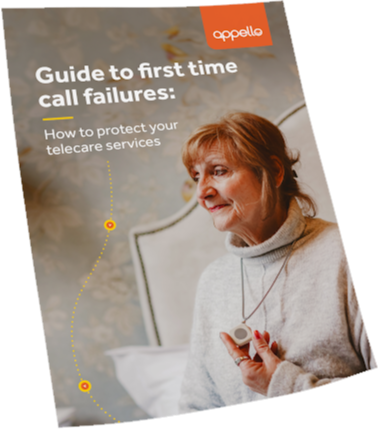Work is well underway on the digital switchover and the impact on analogue telecare services is becoming apparent. As a housing or care provider, this could mean you’re starting to see a greater number of call failures, which is obviously concerning. But what is actually happening – and what does this mean for your monitoring services going forward?
There’s been much discussion in recent years about the changes to our telecoms network, with perhaps some mixed messages about what this will mean for telecare in practice. But we’ve entered a transition period where potential issues with analogue equipment and the digital network are becoming a reality.
In this blog post, we look at some key areas relating to how this may be affecting your monitoring services.
What has Appello done to prepare for the digital switchover?
Everybody involved in delivering telecare services has a responsibility to make sure the products and services are fit for purpose. For the sake of accountability, it’s important to highlight the work we’ve done at Appello to make sure our solutions will work reliably over the digital network.
- Our services and products are all fully digital, having made this a business priority over the last decade. We still maintain the ability to monitor analogue equipment but our services have been designed with digital at the forefront.
- In fact, we received the UK’s first digital telecare call back in 2016.
- This followed our investment in the creation of CareNet, the UK’s first digital call handling platform. This was upgraded in 2022 with the launch of CareNet EVO an even more advanced, robust digital platform.
- We’ve managed over 2 million digital calls – at a time when many other monitoring centres in the country are yet to have digital capability.
- We estimate that we have received and managed more digital calls than the rest of the sector combined.
- We’re accredited by the Quality Standards Framework (QSF) which sets performance benchmarks, including call handling times.
- We’ve also launched our own range of fully digital hardwired and dispersed telecare equipment, in response to the lack of development within the industry. This gives our customers a choice of safe, reliable options that also open up the many additional benefits digital offers.
Alongside this, we’re committed to raising awareness about the digital switchover and its impact on telecare services, with events and digital telecare resources to help you plan your next steps.
How do we know there are issues with analogue telecare equipment on the digital network?
The potential for analogue equipment to be incompatible with the digital network has been flagged by various groups over the last few years. The advice from the telecoms industry (including network operators, such as Openreach, and network providers, such as BT, Virgin Media, TalkTalk etc) and the Technology Enabled Care industry body TSA has been to upgrade to digital equipment.
As the digital rollout progresses, we can see there are indeed issues with analogue equipment. This is particularly apparent with the rise in call failures: recent TSA guidance quoted a failure rate of 2.3-3.6%. The industry body is now coordinating independent testing, as requested by the Department of Health and Social Care, with initial findings showing.”
This corroborates reports from a number of other sources, including research for the NHS Transformation Directorate which quotes failure rates of around 5%, as well as anecdotal reports to Scottish Local Government.
This may seem like a low percentage; however, our experience has been that some analogue equipment is failing upwards of 10%. Therefore, when considering that Appello receive over 200k telecare calls each month, this is thousands of potentially critical calls impacted.
Why are telecare services being impacted by the digital switchover?
Analogue and digital essentially communicate in different languages (or protocols), which can lead to errors as information is shared. This can affect call quality, with distortion on the line, or result in problems connecting the call. There may be multiple connection attempts, delaying the emergency response, or the call may even fail completely.
Crucially, your telecare service may be impacted even if your local telephone exchange has not yet been upgraded to digital. This is because calls are not routed directly: they can cross multiple networks, travelling a seemingly obscure path to connect, and there’s no way to see or predict what locations the call will go through. It is becoming increasingly likely telecare calls will travel across at least a portion of the digital network – and the more times a call needs to be ‘translated’ from analogue to digital and back again, the more opportunity there is for the communication to be corrupted before it reaches the monitoring centre.
Added to this, with many different networks across the country and many different types of telecare equipment in use, there’s a whole host of variables affecting the severity of these analogue to digital issues.
What can your monitoring centre do about call failures?
Your monitoring centre actually has no way of knowing that a call has failed to connect properly, unless this is analysed following the call.
If a problem is flagged by a customer, the monitoring centre can then investigate this to find out where the issue may lie. However, these investigations can be complex, as there are a number of factors that could have impacted the call:
1. Variety of equipment
The monitoring centre deals with equipment from many manufacturers, covering both dispersed and hardwired alarms and the various models of these. For example, Appello monitors around 350K people across the UK, with a significant portion of these still on analogue. This adds up to a lot of variation in equipment that is used. Each piece of equipment acts differently, so investigations need to look at this on a case by case basis.
2. Age of equipment
Communication protocols (i.e. the set of rules or ‘language’) have changed over the years – a 20 year old piece of equipment will not use the same protocol as a device manufactured more recently. We know these protocols have differing failure rates, with some around 3-4%, while others are as much as 20+%.
3. The rollout of the digital network
There may or may not have been changes to the telecoms network geographically which should be taken into account. Our investigations have highlighted some areas where we know there are problems but, as this is changing constantly, it’s impossible to build a complete picture at this stage.
4. Any telecoms work at the property
For example, if new lines have been installed or there have been changes to the telecoms infrastructure within the property. Each telecoms provider is installing different equipment such as digital adapters, each a reacting differently with analogue telecare equipment.
All these factors need to be considered, which requires a bespoke investigation into any call failure.
What we do now from our own investigations, as well as from external reports, is analogue equipment is increasingly resulting in call failures due to compatibility issues with the digital network – and the only real solution is to upgrade to digital telecare.
What can you do to protect your telecare services?
The advice from government and industry bodies, as well as telecoms operators and networks, is that digital telecare is now essential for the ongoing reliability of your telecare services, and therefore the safety of your customers.
It’s important to make sure everyone in your organisation understands the impact of the digital switchover, particularly customer-facing staff, who may be dealing with this without even realising it.
We’ve put together a guide to provide information on the digital switchover and your telecare services that you can share internally. This includes five key steps to help you prepare for digital telecare and a round-up of useful resources.
Download it here: Your guide to the digital switchover and how this could be impacting your telecare services.
You can find more details on the issue of first time call failures in our latest guide, which is available to download now

Talk to us to discuss your requirements and find out about our cost-effective and future proof digital solutions.



